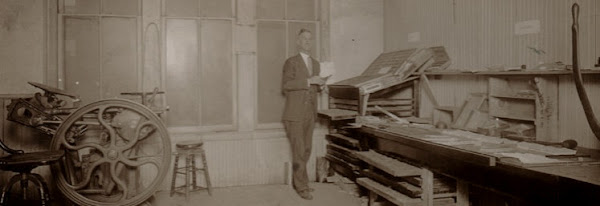Blood of bat and bone of cat,
Tongue of frog and tooth of rat,
Hog’s hair, claw of bear,
Three times three, now follow me…
Ghosts sometimes appear when least expected and at the most inopportune times. This can present problems for those of us who steadfastly deny their existence. But there are times, especially when practicing the ancient craft of printing, that we must at least partially confess the truth that there are more things in heaven and earth than are dreamt of in our philosophy.
I made my second etched plate last weekend, soft ground on a 3” x 4” copper plate. This was done the same as with the pine branch, laying some twine on the grounded plate and running it through the press. As it turned out, I made a mistake when doing this that I’ll detail below. I let it bite for about 25 minutes, a time that was based mostly on my experience with the pine branch and also on the line etching I did as my first experiment. I think I judged it better this time, though I’m happy with the pine branch as well.

To pull the proof I again used Graphic Chemical's Bone Black ink. And except for the final, and I think the best proof, their 150 lb. cotton rag house paper. For that proof I used my trusty unknown 20 lb. laid paper.
The first two proofs are shown above. Note that the one on the left was final wiped with newspaper and the one on the right was hand-wiped. After the first proof I noticed the ghost image circled above and thought it was something I had done during the wipe. But it appeared again on the second proof so I moved the plate slightly on the bed and got the result on the third proof seen above on the right: the same ghost in a different place. Those pesky spirits! I thought about this for a while and before organizing a séance I examined my felts carefully and found a matching depression in the catcher and cushion and then also in the woven pusher on the cylinder. This ghost hadn’t appeared in any other proofs I had pulled previously and it pretty much matches the size of the coil in the noose. And I did in fact run the plate through the press at right angles to the direction I pulled the proofs, which explains the orientation. So my conclusion is that I should have used more padding and less pressure when running the grounded plate through the press. Another lesson learned.
Here is the last proof I pulled which also received a final hand wipe. I’m rather pleased with it and call it Too Much Rope.
P.S. My thanks to Barbee Oliver Carleton for the poem from her children’s story The Wonderful Cat of Cobbie Bean that I first read as a boy in the book, The Arrow Book Of Ghost Stories, that I bought for 15 cents through the Scholastic Book Services at school in the 1960’s. Do they even still have books in school?







